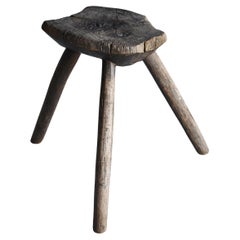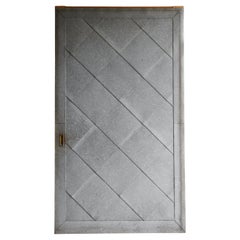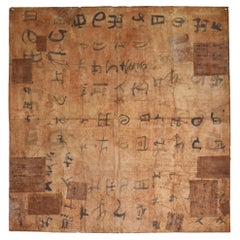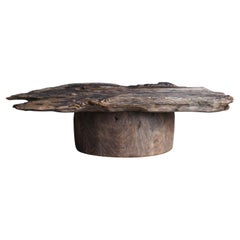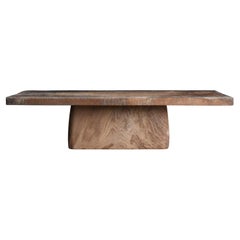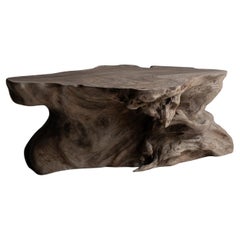Japan
to
445
998,628
705,209
2,238
1,577
898
536
430
414
332
177
143
119
107
96
91
78
60
54
49
46
44
43
25
22
13
12
10
9
7
7
7
7
6
5
5
5
4
3
3
2
2
2
1
1
1
1
1
1
1
1
290
201
66
62
43
Japanese Antique Primitive Stool - Carved from One Solid Block / Wabisabi
By Axel Vervoordt
Located in Chōsei District Nagara, JP
This is an old Japanese primitive-style stool, crafted during the Meiji period (1860s–1900s).
It exudes a simple yet powerful presence. The material is robust chestnut wood, and wha...
Category
Early 20th Century Japanese Primitive Japan
Materials
Chestnut
Japanese Antique Galvanized Steel-Clad Sliding Door 1860s-1920s / Wabisabi
Located in Chōsei District Nagara, JP
This is an old Japanese sliding door covered with corrugated tin.
It was crafted sometime between the Meiji and Taisho periods (1860s–1920s), and such architectural fixtures have bec...
Category
Early 20th Century Japanese Meiji Japan
Materials
Brass, Steel
Japanese Antique Wabi Sabi "Washi" 1897s / Abstract Art Wall Decoration
Located in Chōsei District Nagara, JP
This is an old piece of Japanese washi paper. On the reverse side, the characters “明治三十年” can be seen, indicating it was made in 1897.
While its exact use is uncertain, the presence...
Category
1890s Japanese Meiji Antique Japan
Materials
Paper
Japanese Antique Wabi Sabi Low Table 1860s-1900s / Primitive Sofa Table Mingei
By Axel Vervoordt
Located in Chōsei District Nagara, JP
This is an antique Japanese low table featuring a separate top and base, allowing for easy movement and placement. It is believed to have been crafted in the Meiji period (1860s–1900...
Category
Early 20th Century Japanese Primitive Japan
Materials
Cedar
Japanese Antique Low Table 1860s-1920s / Sofa Table Side Table Wabisabi
By Axel Vervoordt
Located in Chōsei District Nagara, JP
This is an antique Japanese low table, notable for its extremely simple yet powerful structure—consisting of a single solid board resting atop a sturdy base. Both materials date back...
Category
Early 20th Century Japanese Primitive Japan
Materials
Wood, Cedar
Japanese Antique Brutalist Low Table 1900s-1940s / Side Table Wabi Sabi
Located in Sammu-shi, Chiba
apanese Brutalist Zelkova Low Table, Early Showa Period (circa 1900s–1940s)
Carved from a single massive trunk of zelkova, this Japanese low table embodies a striking Brutalist sens...
Category
Early 20th Century Japanese Showa Japan
Materials
Wood
Japanese Old Concrete Sphere Sculpture 1950s-1970s / Object Wabi Sabi
By Axel Vervoordt
Located in Chōsei District Nagara, JP
This is an old Japanese concrete sphere, admired for the unique character it has acquired after decades of exposure to the elements. Its surface is lightly covered with moss, accente...
Category
Late 20th Century Japanese Showa Japan
Materials
Concrete
Japanese Antique Paper-Covered Pottery Jar 1860s-1900s / Flower Vase Wabisabi
By Axel Vervoordt
Located in Chōsei District Nagara, JP
This is an antique Japanese ceramic jar covered with paper, believed to have been made during the Meiji period (1860s–1900s). It was most likely crafted for storing tea leaves, with ...
Category
Early 20th Century Japanese Meiji Japan
Materials
Pottery, Cedar, Paper
Japanese Antique Tansu 1860s-1900s / Sideboard Wabi Sabi #01
Located in Sammu-shi, Chiba
This is a historically significant Japanese Tansu cabinet, crafted from cedar wood during the Meiji period (1860s–1900s).
Its minimalist and refined design embodies traditional Japa...
Category
Late 19th Century Japanese Meiji Antique Japan
Materials
Cedar
Japanese Old Iron Block 1950s-1970s / Display stand Wabi Sabi
Located in Chōsei District Nagara, JP
This is an old Japanese iron block, estimated to have been made in the early Showa period (1950s–1970s). At the time, it was used in ironworks as an anvil or workbench. Decades of us...
Category
Late 20th Century Japanese Showa Japan
Materials
Iron
Antique Khamseh Wool Rug with Birds and Geometric Motifs Tribal Natural Carpet
Located in Tokyo, JP
This striking antique Khamseh rug, handwoven in southern Iran during the late 19th to early 20th century, captures the spirit and vitality of Qashqai tribal artistry. Measuring 133 c...
Category
Early 20th Century Turkish Oushak Japan
Materials
Wool, Natural Fiber, Organic Material
Japanese Antique Cedar Wood Board Wall Decoration 1860s-1900s / Wabi Sabi
By Axel Vervoordt
Located in Chōsei District Nagara, JP
This is an old, single-slab board made of Japanese cedar, believed to date back to the Meiji period (1860s–1900s). Cut from the trunk of a large, centuries-old cedar tree, it retains...
Category
Late 19th Century Japanese Primitive Antique Japan
Materials
Cedar
Japanese Antique 4‑Drawer Storage 1860s-1920s / Tansu Sideboard Wabi Sabi
Located in Chōsei District Nagara, JP
This is an old Japanese chest of drawers, crafted between the Meiji and Taisho periods (1860s–1920s). It retains the rich character and craftsmanship of its era, reflecting the skill...
Category
Early 20th Century Japanese Taisho Japan
Materials
Iron
Japanese Antique Tansu 1860s-1900s / Sideboard Wabi Sabi #02
Located in Sammu-shi, Chiba
This is a historically significant Japanese Tansu cabinet, crafted from cedar wood during the Meiji period (1860s–1900s).
Its minimalist and refined design embodies traditional Japa...
Category
Late 19th Century Japanese Meiji Antique Japan
Materials
Cedar
Japanese Antique Thatching Tools "Gangi" 1860s-1920s / Wall Decoration Wabisabi
Located in Chōsei District Nagara, JP
This is a traditional Japanese thatched roof tool known as a “Gangi.”
A Gangi is used to trim the cut ends of the thatch and smooth the roof’s surface, symbolizing the craftsmanship ...
Category
Early 20th Century Japanese Meiji Japan
Materials
Cedar
Antique Japanese wooden coffee table /Early 20th Century / Wabi-sabi sofa table
Located in Sammu-shi, Chiba
This low table combines a traditional Japanese wooden top and legs. The top is crafted from a single piece of luxurious cedar, enveloping the entire piece with its soft, warm grain. ...
Category
Early 20th Century Japanese Taisho Japan
Materials
Cedar
Simple antique Japanese wooden drawer / 1868-1920 / Meiji-Taisho period
Located in Sammu-shi, Chiba
This is an old Japanese wooden drawer, likely made between 1868 and 1920, during the Meiji and Taisho periods. Crafted from light and warm cedar, the entire piece is crafted from ced...
Category
Late 19th Century Japanese Meiji Antique Japan
Materials
Cedar
Japanese Antique Huge Woven Bamboo Lath Door 1860s-1900s / Abstract Art Wabisabi
By Axel Vervoordt
Located in Chōsei District Nagara, JP
This is an antique large takekomai (woven bamboo lath) door from Japan, crafted during the Meiji period (1860s–1900s). It is made from chestnut wood, bamboo, and straw. Once covered ...
Category
Late 19th Century Japanese Meiji Antique Japan
Materials
Bamboo, Straw, Chestnut
Vintage Malatya Chuval Kilim Cuval Rug Nomadic Anatolian Natural Turkish Carpet
Located in Tokyo, JP
This is a beautifully detailed old Malatya Region, Anatolian Chuval kilim, featuring a bold, three-dimensional texture and precise geometric patterns. Originally used by nomadic trib...
Category
Mid-20th Century Turkish Kilim Japan
Materials
Wool, Natural Fiber, Organic Material
$520 Sale Price
20% Off
Japanese antique pottery with very beautiful colors/ [shigaraki] Jar/1500-1600
Located in Sammu-shi, Chiba
It is "Shigaraki ware".
Shigaraki is a historical kiln located in Shiga Prefecture, Japan. (Shigaraki Kiln is marked with a red circle on the map.)
It is said to have originated in t...
Category
16th Century Japanese Other Antique Japan
Materials
Pottery
Japanese Antique Large Tansu 1860s-1900s / Cabinet Cupboard Wabi Sabi
Located in Chōsei District Nagara, JP
This is an old, large Tansu made in Japan. It is an unusual style with a vertical structure, and is thought to have been made during the Meiji period (1860s-1900s). Unlike most horiz...
Category
Early 20th Century Japanese Meiji Japan
Materials
Cedar
Japanese Antique Small Drawer 1860s-1900s / Nightstand Tansu Wabi Sabi
Located in Chōsei District Nagara, JP
This is an old small drawer storage made in Japan. The furniture was made during the Meiji period (1860s-1900s), and the texture of the wood over the years gives it a deep flavor. Th...
Category
Early 20th Century Japanese Meiji Japan
Materials
Iron
20th century Korean old cloth "pojagi"/Wall hanging object/Tapestry
Located in Sammu-shi, Chiba
This is an old Korean patchwork cloth made around the 20th century.
The name is ``pojagi'' or ``chogappo.''
It is a cloth used to cover, wrap, or wrap things to protect them, and is ...
Category
20th Century South Korean Other Japan
Materials
Cotton
Japanese Antique Paper Wabi-Sabi Washi
Located in Sammu-shi, Chiba
This rare shichou-maku (paper-hung curtain) was crafted during Japan’s Meiji period (late 19th to early 20th century).
It was originally used in sericulture rooms—spaces dedicated ...
Category
Early 19th Century Japanese Edo Antique Japan
Materials
Paper
Japanese Antique Primitive Low Table 1860s-1920s / Wabi Sabi
Located in Sammu-shi, Chiba
This is a very old low table made in Japan.
Its design is simple—consisting of a single slab of wood placed atop a tree stump.
The materials used for both the top and base date back ...
Category
Early 20th Century Japanese Meiji Japan
Materials
Chestnut
Japanese small Black Tansu 1900-1940 / Taisho Period/Cabinet Sideboard Wabisabi
Located in Sammu-shi, Chiba
This is a historically significant Japanese tansu made between the Taisho period and the early Showa period (1910s–1920s).
It is crafted from Japanese cedar wood.
Its minimalist and...
Category
Early 20th Century Japanese Taisho Japan
Materials
Cedar
Japanese antique wooden work board / Wabi sabi / Display stand / Side table
Located in Sammu-shi, Chiba
This is an old Japanese workbench made from zelkova wood (keyaki),
known for its strength and beautifully distinct grain.
The thick cross-section c...
Category
20th Century Japanese Taisho Japan
Materials
Wood
Japanese Antique Cabinet with Glass Doors, Taisho Era (1912–1926), Wabi-Sabi
Located in Hitachiomiya-shi, 08
This antique cabinet with glass sliding doors was crafted in the Taisho Era (1912–1926).
Built in Japanese cherry and cedar with persimmon-wood drawer fronts, and finished in tradit...
Category
Early 20th Century Japanese Taisho Japan
Materials
Wood, Cherry, Cedar
Japanese Antique Small Door Wall Decoration 1860s-1900s / Abstract Art Wabi Sabi
Located in Chōsei District Nagara, JP
This is an old small window frame made in Japan. It was originally used as a traditional Japanese mud wall fixture. It dates back to the Meiji period (1860s-1900s) and has been in us...
Category
Early 20th Century Japanese Meiji Japan
Materials
Bamboo, Cedar
Japanese Antique Shigaraki Ware 18th Century / Pottery Vase Wabi Sabi
Located in Chōsei District Nagara, JP
This is an old, large Shigaraki ware pot made in Japan.
It is estimated to have been produced in the late Edo period, around the 18th century. Among traditional Japanese ceramics, Sh...
Category
Late 18th Century Japanese Edo Antique Japan
Materials
Pottery
Japanese Antique Drawer / Storage Tansu / 1868-1912s / Wabi-Sabi Mingei
Located in Iwate-gun Shizukuishi-cho, Iwate Prefecture
This is an antique Japanese-made drawer.
It is thought to date to the Meiji period, made primarily of paulownia and cedar.
In addition to the reddish tinge that comes with years of...
Category
Late 19th Century Japanese Meiji Antique Japan
Materials
Iron
F.171201 by Toshio Iezumi - Contemporary glass sculpture, green, abstract, light
By Toshio Iezumi
Located in Paris, FR
F.171201 is a glass sculpture by Japanese contemporary artist Toshio Iezumi, dimensions are 17 × 42 × 35 cm (6.7 × 16.5 × 13.8 in).
The sculpture is signed and numbered, it is part ...
Category
2010s Contemporary Japan
Materials
Glass
Ararat Rugs Oversized Mamlouk Rug A Majestic Revival of Islamic Artistry Carpet
By Ararat Rugs
Located in Tokyo, JP
Origin and Inspiration:
The Mamlouk Rug is a contemporary masterpiece that draws its inspiration from the rich textile traditions of the Mamlouk Sultanate, which reigned over Egypt a...
Category
21st Century and Contemporary Turkish Revival Japan
Materials
Wool, Natural Fiber, Organic Material
Vintage & Old Kilim Cushion Cover, Anatolian Yastik Turkish Modern Pillow 4337
Located in Tokyo, JP
This beautifully handcrafted cushion cover is made from a vintage Anatolian kilim—once part of a traditional yastik, or small decorative rug used in Turkish homes. Woven in the mid-2...
Category
2010s Turkish Kilim Japan
Materials
Natural Fiber, Organic Material
$144 Sale Price
20% Off
Japanese antique Bizen ware vase / 15th-16th century / Wabi-sabi vase/Tsubo
Located in Sammu-shi, Chiba
This Bizen ware jar was fired in the Bizen region of Okayama Prefecture. Bizen ware is one of Japan's Six Ancient Kilns and is known as one of the oldest pottery styles in Japan. Its...
Category
16th Century Japanese Other Antique Japan
Materials
Pottery
Japanese Antique Artillery Shell 1900s-1920s / Iron Ball Object Wabisabi
Located in Chōsei District Nagara, JP
This is an old Japanese artillery shell.
From its appearance, it is assumed that it is an iron shell for artillery.
Considering the size, shape, and rusty condition of this iron ball...
Category
1910s Japanese Showa Vintage Japan
Materials
Iron
Japanese Antique Drawer 1860s-1920s / Nightstand Tansu Wabisabi
Located in Chōsei District Nagara, JP
This is an old drawer storage made in Japan.
It was made between the Meiji and Taisho periods (1860s-1920s). The material used is cedar wood, and iron hardware is attached to the han...
Category
Early 20th Century Japanese Taisho Japan
Materials
Iron
Ararat Rugs Anatolian Medallion Carpet, 16th Century Revival Rug Natural Dyed
By Ararat Rugs
Located in Tokyo, JP
The source of the carpet comes from the book Orient Star - A Carpet Collection, E. Heinrich Kirchheim, Hali Publications Ltd, 1993 nr.178. This is an unusual border drawing, a medall...
Category
21st Century and Contemporary Turkish Oushak Japan
Materials
Wool, Natural Fiber, Organic Material
Japanese Antique Large Black Tansu / Cabinet Sideboard / 1868-1912s Wabi-sabi
Located in Iwate-gun Shizukuishi-cho, Iwate Prefecture
This is an old Japanese tansu.
It was used in the Tohoku region around the Meiji period, and is made primarily of pine and cedar.
It has an unusual design with a short depth and sl...
Category
Late 19th Century Japanese Meiji Antique Japan
Materials
Iron
Japanese Antique Cabinet 1860s-1920s / Tansu Sideboard Wabisabi
Located in Chōsei District Nagara, JP
This is an old storage cabinet made in Japan.
It is a piece of furniture made between the Meiji and Taisho periods (1860s-1920s), and it is a piece of furniture that has passed throu...
Category
Early 20th Century Japanese Taisho Japan
Materials
Iron
Japanese Antique Chest of Drawers 1860s-1900s / Tansu Nightstand Wabi Sabi
Located in Chōsei District Nagara, JP
This is an old drawer storage made in Japan.
This furniture was made during the Meiji period (1860s-1900s) and is a valuable piece of furniture that has transcended time and remains ...
Category
Early 20th Century Japanese Meiji Japan
Materials
Iron
Old Korean Fan / 20th Century / Wall Hanging / Folk Art / MINGEI
Located in Sammu-shi, Chiba
I was able to acquire a truly wonderful item.
This is an old Korean "uchiwa" (fan).
An "uchiwa" is a tool used by hand to create a breeze.
It was used to cool down on hot summer da...
Category
20th Century South Korean Other Japan
Materials
Bamboo, Paper
Japanese Antique Black Drawer Storage 1860s-1900s / Tansu Sideboard Wabi Sabi
Located in Chōsei District Nagara, JP
This is a black drawer storage made in Japan.
This furniture was made in the Meiji period (1860s-1900s) and is made of cedar wood. Cedar is lightweight yet strong, and was widely use...
Category
Early 20th Century Japanese Meiji Japan
Materials
Iron
Edo period Japanese Screen. Tiger and Pine by Kishi Ganku.
Located in Kyoto, JP
Kishi Ganku (1749/1756-1838)
Tiger and Pine
A six-panel Japanese Screen. Ink on silver leaf.
The central focus of this Japanese screen is a large tiger, emerging from shadow, crou...
Category
Late 18th Century Japanese Edo Antique Japan
Materials
Silver Leaf
Japanese Antique Black Drawer Storage 1860s-1900s / Tansu Sideboard Wabisabi
Located in Chōsei District Nagara, JP
This is an old drawer storage made in Japan.
It was made during the Meiji period (1860s-1900s) and is a valuable antique piece of furniture filled with Japanese craftsmanship. The ma...
Category
Early 20th Century Japanese Meiji Japan
Materials
Iron
Antique wall-hanging vase made from Japanese bamboo/River fishing equipment
Located in Sammu-shi, Chiba
This is a traditional Japanese fishing implement called an "uke," crafted from bamboo during the Meiji to early Showa period. It was placed in rivers to trap eels and loaches, which,...
Category
Late 19th Century Japanese Taisho Antique Japan
Materials
Bamboo
Kaj Franck / KF2 HORS D'OEUVRE DISH(BROWN) / Arabia Finland
By Kaj Franck, Arabia of Finland
Located in Shibuya-Ku, JP
KF2 was designed in 1957 and manufactured from 1958 to 1962.
A geometric-shaped appetiser dish. One of Kai Franck's masterpieces, combining structural beauty with functional elegance...
Category
1950s Finnish Scandinavian Modern Vintage Japan
Materials
Ceramic
Japanese Antique Large Mizuya Tansu, Meiji Era '1868–1912', Wabi Sabi
Located in Hitachiomiya-shi, 08
This antique large Mizuya Tansu was crafted in the Meiji Era (1868–1912).
Finished with traditional Japanese urushi lacquer, the surface has deepened to a rich black over time, show...
Category
Mid-19th Century Japanese Meiji Antique Japan
Materials
Cedar
Circa 1900 Japanese Pine Screen Pair. Aged Dragons by Suzuki Shonen.
Located in Kyoto, JP
Suzuki Shonen (1848-1918)
Aged Dragons
A pair of six-panel Japanese screens. Ink and gold leaf on paper.
Dimensions: Each Screen: H. 170 cm x 378 cm (67" x 149")
As with the pair...
Category
Early 20th Century Japanese Meiji Japan
Materials
Gold Leaf
Japanese Antique Large Black Sideboard 1860s-1900s / Tansu Wabisabi
Located in Chōsei District Nagara, JP
This is an old, large sideboard made in Japan.
The furniture was made during the Meiji period (1860s-1900s) and has a deep black paint throughout, giving it a stately appearance.
The...
Category
Early 20th Century Japanese Meiji Japan
Materials
Iron
Japanese antique small wooden storage shelf / Early 20th century
Located in Sammu-shi, Chiba
This compact yet finely crafted piece of furniture was made in Japan in the early 20th century. Likely constructed from aged cedar or cypress, the wood has developed a rich patina ov...
Category
Early 20th Century Japanese Taisho Japan
Materials
Cedar
Japanese Old Primitive Side Chair 1950s-1970s / Wabi Sabi
Located in Chōsei District Nagara, JP
This is an old side chair made in Japan.
It was made in the postwar period (1950s-1970s), and the material used is cedar wood with a rustic look.
The structure, carved in one piece ...
Category
Late 20th Century Japanese Primitive Japan
Materials
Cedar
Japanese Antique Side Table, Late Meiji Era '1868–1912', Wabi Sabi
Located in Hitachiomiya-shi, 08
This antique side table was crafted in the Late Meiji Era (1868–1912).
The top is made from solid zelkova (keyaki) wood, paired with legs crafted from cedar. The surface has develope...
Category
Early 20th Century Japanese Meiji Japan
Materials
Cedar
Japanese Antique Warped coffee table / sofa table / Wabi-sabi Primitive
Located in Iwate-gun Shizukuishi-cho, Iwate Prefecture
This coffee table is crafted from reclaimed Japanese wood.
The tabletop is a very strong, heavy board that was used as a workbench for many years. Its thickness is marked by strikin...
Category
Late 19th Century Japanese Primitive Antique Japan
Materials
Hardwood, Chestnut
1940s Japanese vintage glass cabinet w/drawers, bookcase wabi sabi organic
Located in 常陸大宮市, JP
New finds from Kominka (old traditional style house) owned by an old established family, Ibaraki pref. , Japan.
This vintage glass cabinet was manufactured as bookcase in circa 194...
Category
1940s Japanese Organic Modern Vintage Japan
Materials
Wood, Ash
1870s-1900s Japanese antique Mizuya tansu chest sideboard wabi sabi primitive
Located in 常陸大宮市, JP
New finds from Tohoku area, Japan.
This single tier Mizuya tansu is made from premium quality, reddish Sugi Cedar, the product of circa 1870s to 1900s (Meiji to early Taisho period)...
Category
Late 19th Century Japanese Meiji Antique Japan
Materials
Wood, Cedar
Edo Period Horagai – Ritual Conch Shell Trumpet
Located in Fukuoka, JP
A rare and authentic Edo period (1603–1868) horagai—a conch shell trumpet traditionally used in Japanese Buddhist rituals, Shugendō mountain ascetic practices, and by yamabushi (moun...
Category
18th Century Japanese Edo Antique Japan
Materials
Shell
Japanese Antique Drawer Storage 1860s-1920s / Tansu Sideboard Wabisabi
Located in Chōsei District Nagara, JP
This is an old drawer storage made in Japan.
It is a historic piece of furniture made during the Meiji and Taisho periods (1860s-1920s).
The material is cedar wood. The handles are m...
Category
Early 20th Century Japanese Meiji Japan
Materials
Iron
Japanese Antique Large Black Tansu 1860s-1900s / Cabinet Sideboard Wabi Sabi
Located in Chōsei District Nagara, JP
This is an old large Tansu made in Japan.
This furniture was made during the Meiji period (1860s-1900s).
The material used is cedar wood. The iron metal fittings in the center add an...
Category
Early 20th Century Japanese Meiji Japan
Materials
Iron
1940s Japanese vintage solid wood 4 tier tall storage shelf wabi sabi organic
Located in 常陸大宮市, JP
From Tohoku area, Japan.
This vintage, simple yet bold shelf unit was manufactured in circa 1940s to 60s, estimate from the style & condition.
Structural parts are made of reddish,...
Category
Early 20th Century Japanese Organic Modern Japan
Materials
Cedar, Wood
